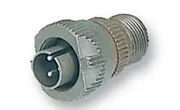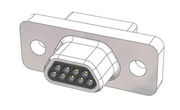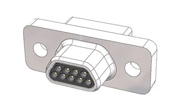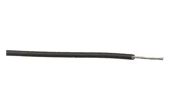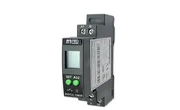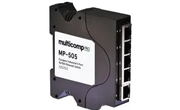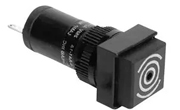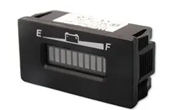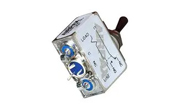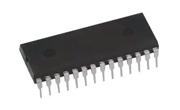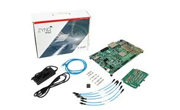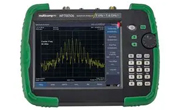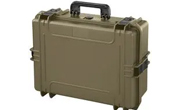Advanced defense technologies: Powering modern defense operations
Modern times have witnessed the critical role of advanced technology in shaping modern security operations. Every aspect of land, air, sea, cyber, and space-based defense depends on highly specialized systems, where electronics, artificial intelligence, and communication technologies play a vital role in mission success.
This article will discuss how advanced semiconductors, high-speed networking, ruggedized electronics, and AI algorithms have transformed security strategies and mission effectiveness.
Surveillance and intelligence gathering
Military surveillance systems consist of a combination of regular visible-light cameras, thermal imagers, and infrared sensors. The aim is to achieve an integrated zero-blind spot approach that includes automatic real-time intelligence gathering for threat detection, examining risk assessment, and enhancing situational awareness with unmatched precision and efficiency 24/7 in any condition. Defense cameras provide military agencies with real-time intelligence for border security, threat detection, and tactical response, from daylight reconnaissance and night vision operations to thermal detection through smoke and fog. Here are the different types-
- Surveillance Cameras: Provide continuous monitoring with pan, tilt, and zoom capabilities. These are usually deployed on stationary or mobile platforms for real-time intelligence.
- Thermal imaging Cameras: Detect heat signatures in low visibility, enhancing situational awareness for field commanders on vehicles and aircraft.
- Night Vision Cameras Amplify ambient light for clear visibility in darkness. They are often paired with thermal imaging for enhanced target detection.
- Long-Range Cameras: Offer extended surveillance with high magnification zoom and image stabilization, mounted on vehicles and aircraft.
- Forward-Looking Infrared (FLIR): This technology generates thermal images from infrared radiation, enabling the detection of heat-emitting objects in darkness or obscured conditions.
- Shortwave Infrared (SWIR): Offers better visibility beyond the range of the human eye and is critical for surveillance operations as it can penetrate fog, smoke, and glass.
- Mid-Wave Infrared (MWIR): This wavelength detects temperature variations with superior clarity, making it ideal for night vision and thermal tracking in dynamic environments.
- Longwave Infrared (LWIR): This type of imaging helps detect concealed objects or personnel, as it can capture faint thermal signatures in low-light scenarios.
Tactical communications & networking
Encryption and anti-jamming technologies protect data from being intercepted and subsequent manipulation. They are a part of tactical communications. When combined with low-latency, high-reliability networks, tactical communications enable seamless coordination in field operations and across command units. The communications architecture must be sufficiently scalable and robust for enhanced operational efficiency, high-speed data exchange, and even strategic decision-making in critical missions. The types of communication systems in defense include:
- Mobile Cellular Communication System (MCCS): Mobile networks used in defense have CDMA-based architecture, integrating MSC, static BTS, and mobile/micro BTS sites for flexible deployment. The coverage of these networks can be tailored to operational needs. Communication can be enhanced via SMS, VMS, MMS and other value-added services if required. In-house secure mobile handsets ensure encrypted voice and data transmission. High-speed data is protected with encryption-enabled dongles, enabling secure connectivity for data-intensive applications. With 5G, ultra-reliable broadband extends across all defense operations, ensuring seamless, mission-critical communication in any deployment scenario.
- IP Gateway: The IP Gateway enables seamless communication across multiple interfaces, including POTS, magneto subscribers, CNR voice, analogue/digital trunk, AREN (CCS), and VoIP. Designed for extreme environments, it operates between -20°C to +55°C and meets JSS55555 L2H ruggedization and MIL-STD 461E EMI/EMC standards. Supporting multiple soft operator stations ensures flexible deployment in mission-critical networks. It's compact 4U height and 19" rack-mountable design integrate effortlessly into defense communication infrastructures.
- Radio Communication Systems: Multi-frequency voice and data transmission ensures secure, long-range field communication via handheld, high-frequency, and satellite radios.
- Satellite Communication (SATCOM): Provides global connectivity for seamless coordination between air, land, and naval forces, ensuring real-time data sharing.
- Software-defined radios (SDR): SDRs improve interoperability across defense branches by dynamically switching frequencies and adapting to protocols.
- Secure Communication Systems: Data confidentiality is ensured through advanced encryption and access controls, which safeguard transmissions against interception.
Video 1: Analog Devices: 5G Leadership - Testing, Building, & Harnessing 5G
Critical cyber defense technologies
Cyber threats can destabilize national security, critical infrastructure, and defense operations depends on cyber systems for communication, intelligence, and even logistics. Advanced cyber defense technologies thus ensure network resilience, secure communications, and real-time threat mitigation. The following are the most critical cyber defense technologies shaping military and defense cybersecurity.
- Artificial Intelligence (AI) for Threat Detection & Response: AI-driven cybersecurity automates real-time anomaly detection, zero-day vulnerability identification, and predictive threat analysis using machine learning. Behavioral analytics differentiate between legitimate and malicious activities, enabling automated incident response with minimal human intervention. AI-driven systems neutralize threats before they infiltrate critical networks.
- Quantum Cryptography & Secure Communications: Quantum Key Distribution (QKD) ensures unbreakable encryption and stops unauthorized access to critical military communications. QKD leverages quantum entanglement to secure data exchanges against interception. Strategic data is safeguarded by making quantum computers' cryptographic keys immune to decryption, and classified military communications remain impenetrable to cyber espionage.
- Zero Trust Architecture (ZTA): ZTA enforces continuous verification, least-privilege access, and micro-segmentation, ensuring no entity is inherently trusted. Multi-factor authentication (MFA), access control, and real-time user monitoring eliminate internal and external cyber risks and, as a consequence, prevent the lateral movement of attackers. It blocks unauthorized access and mitigates insider threats through strict authentication policies.
- Secure Military Cloud & Data Encryption: Cloud security integrates homomorphic encryption, data fragmentation, and multi-layered access controls to protect classified intelligence. AES-256 and post-quantum cryptographic techniques ensure secure storage, processing, and remote access of mission-critical data in defense networks. It also prevents data breaches by securing classified intelligence with military-grade encryption.
- Advanced Intrusion Detection & Prevention Systems (IDPS): Next-generation IDPS employs deep packet inspection (DPI), AI-powered anomaly detection, and signature-based threat identification to detect and neutralize cyberattacks before infiltrating networks. Automated response mechanisms block malicious traffic in real-time, ensuring operational continuity.
Autonomous systems & robotics
Autonomous defense systems reduce human exposure to threats, including unmanned drones, ground robots, and maritime platform systems. They integrate advanced robotics to execute high-risk, complex missions. They have enhanced situational awareness, accelerated response times, and enabled remote operations.
AI-Driven Aerial Reconnaissance: UAVs with multi-spectral imaging, LiDAR, and real-time AI analytics conduct autonomous surveillance, terrain mapping, and target tracking. For example, electric vertical take-off and landing vehicles (eVTOLs) offer efficient, runway-free operation with tilting engines for enhanced flight. They feature more straightforward controls and the potential for full autonomy. Optimized for urban airspace, eVTOLs reduce congestion and travel times by transporting passengers and cargo above traffic.
Connectors and cables are critical to eVTOL design, ensuring efficiency, reliability, and safety across power, communication, and sensor systems. Circular connectors enable high-power delivery from batteries to motors, handling high voltages and currents while maintaining insulation and durability in extreme conditions. D-shaped connectors support sensor-driven navigation and flight control, offering secure, shock-resistant connections for real-time data transmission. RF & Microwave connectors facilitate low-latency, high-speed data transfer for 5G communication and autonomous flight, ensuring signal integrity in demanding environments. Compression connectors enhance quick-charging reliability, withstanding extreme voltages, currents, and environmental stresses to enable safe and efficient battery charging.
Automated Border Surveillance: Sensor-integrated robotic patrol units utilize autonomous navigation, infrared detection, and pattern recognition to monitor perimeters and detect unauthorized movement.
Unmanned Aerial and Maritime Operations: Military Unmanned Aerial Vehicle (UAV) drones must be compact, lightweight, and feature-rich while enduring extreme temperatures (-55°C to +200°C), harsh weather, shock, and vibration. Designed for high-altitude operations and frequent handling, they require rugged, high-performance electronics to ensure reliability and mission success in challenging environments.
UAV connectors must be lightweight, compact, and highly reliable to support advanced features like GPS, cameras, sensors, and secure wireless communication while ensuring resistance to electronic interference. MIL-DTL-83513-compliant microminiature D-Type connectors are standard in military drones, while emerging nano-miniature connectors aim to further reduce weight and size without compromising performance, offering low contact resistance, high current capacity, and strong dielectric strength.
AI-powered submersibles leverage acoustic signal processing and sonar imaging to track underwater threats, scan seabeds, and monitor naval zones.
Threat Detection & Response: Autonomous platforms utilize edge computing, computer vision, and sensor fusion to identify anomalies, predict threats, and relay actionable intelligence.
AI-powered navigation uses reinforcement learning and computer vision for autonomous pathfinding in GPS-denied environments. MEMS-based sensors, including accelerometers, gyroscopes, and magnetometers, enable real-time stability, positioning, and terrain adaptation. High-speed 5G and encrypted data links ensure secure, low-latency command, control, and intelligence transmission across unmanned aerial, ground, and underwater systems.
Multi-domain extreme environment operations
Multi-domain operations (MDO) integrate land, sea, air and space capabilities to achieve strategic and operational goals. Defense electronics must withstand extreme conditions, including high desert temperatures, freezing polar climates, and humid rainforest environments, ensuring reliable performance across all domains.
- High-altitude and Arctic missions: These situations demand operational resilience in extreme cold, low oxygen, and severe weather conditions. AI-driven UAVs enable real-time intelligence at high altitudes, where they conduct reconnaissance in thin-air environments, IoT-based climate control systems sustain habitable conditions in cold-weather military bases, ensuring personnel safety. Battery-heated clothing, thermal imaging, and biometric wearables enhance survivability, enabling effective operations in arctic conditions.
- Deep-sea and Naval operations: AI-powered sonar systems employed by deep-sea and naval operations provide real-time surveillance, identifying anomalies and unauthorized presence in deep waters. At the same time, fiber-optic communication networks ensure encrypted, long-range data transmission between naval fleets and unmanned underwater drones. Autonomous unmanned underwater vehicles (UUVs) conduct deep-sea intelligence gathering, mapping ocean floors, and monitoring strategic waterways with minimal human intervention. These operations depend on corrosion-resistant connectors and interconnect for long-term reliability, while high-temperature fiber-optic systems maintain secure, interference-free communication in extreme underwater conditions. AI-driven navigation improves submersible autonomy, enabling precise maneuvering in GPS-denied environments. Naval capabilities are strengthened, with improved operational efficiency in deep-sea missions.
Video 2: Know more about Aerospace and Defense Capabilities
Conclusion
Every aspect of modern defense operations relies on cutting-edge electronics. Innovations such as AI-driven surveillance and cybersecurity to autonomous systems and space-based intelligence ensure resilience in extreme conditions, whether in deep-sea deployments, space missions, or arctic operations. The future of security depends on the continued integration of advanced electronics and AI-driven automation, making global defense smarter, faster, and more reliable than ever. Farnell provides a comprehensive selection of defense-grade components that meet military and aerospace standards, ensuring rapid global delivery for critical projects.
